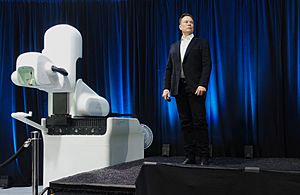Neuralink facts for kids
 |
|
| Private | |
| Industry | Brain–computer interface Neuroprosthetics |
| Founded | June 21, 2016 |
| Headquarters | Fremont, California, U.S. |
|
Key people
|
Jared Birchall (CEO) |
| Owner | Elon Musk |
|
Number of employees
|
c. 300 (2022) |
Neuralink Corp. is an American company that creates special brain implants. These implants are called brain–computer interfaces (BCIs). They help connect brains directly to computers. Neuralink is based in Fremont, California.
Elon Musk and a team of seven scientists and engineers started Neuralink in 2016. The public first heard about the company in March 2017. Since then, Neuralink has hired many top brain scientists. By July 2019, the company had received $158 million in funding. Elon Musk provided $100 million of this money.
At that time, Neuralink announced a special "sewing machine-like" device. This device can put very thin threads into the brain. These threads are only 4 to 6 micrometers wide. They also showed a system that could read information from a lab rat. This system used 1,500 tiny electrodes. Neuralink hoped to start human experiments in 2020. This goal was later moved to 2023. In May 2023, the company received approval to test its devices on humans in the United States.
Contents
About Neuralink
How Neuralink Started
Neuralink began in 2016. Elon Musk and seven other experts founded it. The first team included scientists who knew a lot about brains, body chemistry, and robots. The name "Neuralink" was bought in January 2017.
In April 2017, Neuralink shared its goals. In the short term, they wanted to make devices to help with serious brain diseases. Their long-term goal was to improve human abilities. This idea is sometimes called transhumanism. Elon Musk said he was interested in this idea because of a science fiction concept. It was called "neural lace" from a book series by Iain M. Banks.
Musk described the neural lace as a "digital layer" over the brain. He hoped it would not need big surgery. Ideally, it could be put in through a vein or artery. He believes the long-term goal is to work together with artificial intelligence. Musk sees uncontrolled AI as a big danger to humanity. He thinks the device could be like a "saved game" in a video game. It would let you "resume and upload your last state." He also believes it could help with brain or spinal injuries. It could make up for lost abilities with a chip.
In 2020, Neuralink's main office was in San Francisco. It shared a building with OpenAI, another company Elon Musk helped start. By 2022, Neuralink's headquarters moved to Fremont, California. Jared Birchall is the CEO of Neuralink. Elon Musk is the main owner of Neuralink.
In April 2021, Neuralink showed something amazing. A monkey played the game "Pong" using only its brain and the Neuralink implant. Similar technology has been around since 2002. But scientists noted that Neuralink made the implant wireless. They also greatly increased the number of electrodes.
How Neuralink Works
Neuralink has kept its work very secret for a long time. Public records showed they wanted to open an animal testing center. They later started research at the University of California, Davis. In 2019, Neuralink showed its first prototype to the public. This system uses very thin probes inserted into the brain. A special robot does the surgery. There is also an electronic system. This system can process information from brain cells, called neurons.
Tiny Probes
The probes are made of a safe material called polyimide. They have thin gold or platinum wires. A surgical robot puts these probes into the brain. Each probe has wires with electrodes. These electrodes can find electrical signals in the brain. They also have a sensory area. This area connects the wire to an electronic system. This system helps to make the brain signal stronger and collect it. Each probe has 48 or 96 wires. Each wire has 32 separate electrodes. This means one system can have up to 3072 electrodes.
Surgical Robot
Neuralink has built a special surgical robot. This robot can quickly put many flexible probes into the brain. This helps avoid damage to brain tissue. It also helps the probes last longer. The robot's insertion head has a tiny needle. This needle is only 40 micrometers wide. It is made of tungsten and rhenium. It can attach to the probes and put them into the brain. It can insert up to six wires (192 electrodes) every minute. A motor helps the needle move very fast. The robot also has a camera. This camera helps guide the needle. It shows the insertion in real-time. It also checks that everything is correct.
Smart Electronics
Neuralink has created a special computer chip. This chip can record signals from 1,536 channels. It has 256 amplifiers that can be programmed. It also has parts that turn brain signals into digital information. The goal is to turn brain signals into a computer code. This helps us understand how the brain works. It also helps to send signals back to the brain.
With current technology, Neuralink's electrodes are still too big. They cannot record signals from single neurons. They can only record signals from groups of neurons. Neuralink believes they can fix this with computer programs. However, it takes a lot of computer power. It also does not give exact results.
In July 2020, Neuralink received a special approval from the FDA. This approval allows limited human testing. It follows the FDA's rules for medical devices.
Animal Testing
Neuralink tests its devices by putting them into the brains of live animals. They test on monkeys, pigs, and other animals. Groups like PETA have criticized Neuralink's methods. From 2017 to 2020, Neuralink worked with UC Davis for its monkey experiments.
Human Testing
Neuralink got approval from the FDA for human clinical trials in May 2023. The FDA had previously said no to a request in 2022. They had "major safety concerns." These concerns included the device's battery. They also worried about the tiny wires moving to other parts of the brain. There were also questions about how to remove the device without damaging brain tissue.
In September 2023, Neuralink started looking for people for its first human trials. This was allowed by the FDA.
On January 29, 2024, Elon Musk announced good news. Neuralink had successfully put a device into a human brain the day before. Musk said the patient was recovering well from the surgery. He also said that early results showed "promising neuron spike detection." This means the device was successfully picking up brain signals.
See also
 In Spanish: Neuralink para niños
In Spanish: Neuralink para niños
- Brain–computer interface
- Cortical implant
- Electrocorticography
- Kernel (neurotech company)
- Mind uploading
- Neurorobotics
- Surface chemistry of neural implants
- Stentrode



